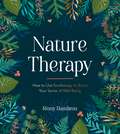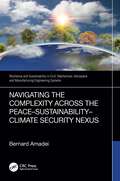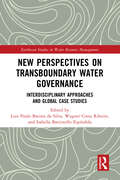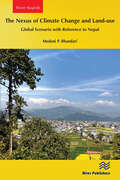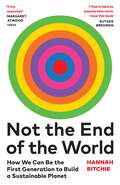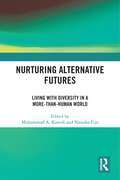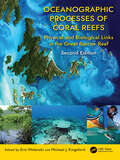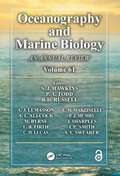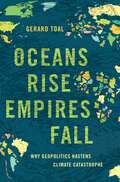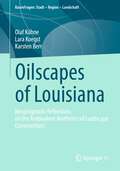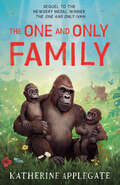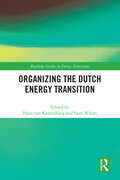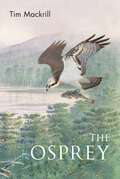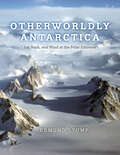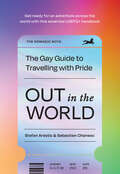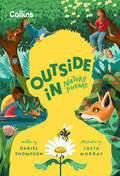- Table View
- List View
Nature Therapy: How to Use Ecotherapy to Boost Your Sense of Well-Being
by Rémy DambronNature therapy is the practice of reconnecting with the natural world to refresh your physical and mental well-being. Including tips to help you discover your connection with the outdoors, activity inspiration and a holistic approach to wellness, this book is the ultimate guide to unlocking the transformative power of nature.
Navigating the Complexity Across the Peace–Sustainability–Climate Security Nexus (Resilience and Sustainability in Civil, Mechanical, Aerospace and Manufacturing Engineering Systems)
by Bernard AmadeiPromoting peace and sustainability in human development while accounting for the risks associated with the impact of climate change on society has become more imperative than ever when addressing humanity's challenges of the twenty-first century. There is enough evidence that peace, sustainability, and climate security are entangled with multiple complex interactions and cannot be dealt with in isolation and independently from the environment and the numerous systems with which they interact. Yet, the intersection of peace, sustainability, and climate security or their opposites (i.e., conflict, unsustainability, and climate vulnerability) is rarely articulated with a systemic mindset. A multi-solving nexus approach is more appropriate to capture the complexity and uncertainty of how the three sectors of peace, sustainability, and climate security play a role in community development, the nature of their causal chains, and the feedback on how community development affects the three sectors. Navigating the Complexity Across the Peace–Sustainability–Climate Security Nexus explores the value proposition of using a systems approach, methodology, and tools to comprehend and model that dynamic. Features of the book: Explores the interaction between the different components of peace and the relationship between peace, sustainability, and climate security using semi-qualitative and quantitative tools; Explains how climate adaptation and mitigation are related to peace or conflict; Presents generic system dynamics modeling that can be used in different contexts.
Navigating the Complexity Across the Peace–Sustainability–Climate Security Nexus (Resilience and Sustainability in Civil, Mechanical, Aerospace and Manufacturing Engineering Systems)
by Bernard AmadeiPromoting peace and sustainability in human development while accounting for the risks associated with the impact of climate change on society has become more imperative than ever when addressing humanity's challenges of the twenty-first century. There is enough evidence that peace, sustainability, and climate security are entangled with multiple complex interactions and cannot be dealt with in isolation and independently from the environment and the numerous systems with which they interact. Yet, the intersection of peace, sustainability, and climate security or their opposites (i.e., conflict, unsustainability, and climate vulnerability) is rarely articulated with a systemic mindset. A multi-solving nexus approach is more appropriate to capture the complexity and uncertainty of how the three sectors of peace, sustainability, and climate security play a role in community development, the nature of their causal chains, and the feedback on how community development affects the three sectors. Navigating the Complexity Across the Peace–Sustainability–Climate Security Nexus explores the value proposition of using a systems approach, methodology, and tools to comprehend and model that dynamic. Features of the book: Explores the interaction between the different components of peace and the relationship between peace, sustainability, and climate security using semi-qualitative and quantitative tools; Explains how climate adaptation and mitigation are related to peace or conflict; Presents generic system dynamics modeling that can be used in different contexts.
New Perspectives on Transboundary Water Governance: Interdisciplinary Approaches and Global Case Studies (Earthscan Studies in Water Resource Management)
This book presents a novel examination of transboundary water governance, drawing on global case studies and applying new theoretical approaches. Excessive consumption and degradation of natural resources can either heighten the risks of conflicts or encourage cooperation within and among countries, and this is particularly pertinent to the governance of water. This book fills a lacuna by providing an interdisciplinary examination of transboundary water governance, presenting a range of novel and emerging theoretical approaches. Acknowledging that issues vary across different regions, the book provides a global view from South and Central America, Africa, Asia, and the Middle East, with the case studies offering civil society and public managers concrete situations that indicate difficulties and successes in water sharing between bordering countries. The volume highlights the links between natural resources, political geography, international politics, and development, with chapters delving into the role of paradiplomacy, the challenges of climate change adaptation, and the interconnections between aquifers and international development. With rising demand for water in the face of climate change, this book aims to stimulate further theoretical, conceptual, and methodological debate in the field of transboundary water governance to ensure peaceful and fair access to shared water resources. This book will be of interest to students and scholars of water resource governance from a wide variety of disciplines, including geography, international relations, global development, and law. It will also be of interest to professionals and policymakers working on natural resource governance and international cooperation.
New Perspectives on Transboundary Water Governance: Interdisciplinary Approaches and Global Case Studies (Earthscan Studies in Water Resource Management)
by da Silva, Luis Paulo Batista Wagner Costa Ribeiro Isabela Battistello EspíndolaThis book presents a novel examination of transboundary water governance, drawing on global case studies and applying new theoretical approaches. Excessive consumption and degradation of natural resources can either heighten the risks of conflicts or encourage cooperation within and among countries, and this is particularly pertinent to the governance of water. This book fills a lacuna by providing an interdisciplinary examination of transboundary water governance, presenting a range of novel and emerging theoretical approaches. Acknowledging that issues vary across different regions, the book provides a global view from South and Central America, Africa, Asia, and the Middle East, with the case studies offering civil society and public managers concrete situations that indicate difficulties and successes in water sharing between bordering countries. The volume highlights the links between natural resources, political geography, international politics, and development, with chapters delving into the role of paradiplomacy, the challenges of climate change adaptation, and the interconnections between aquifers and international development. With rising demand for water in the face of climate change, this book aims to stimulate further theoretical, conceptual, and methodological debate in the field of transboundary water governance to ensure peaceful and fair access to shared water resources. This book will be of interest to students and scholars of water resource governance from a wide variety of disciplines, including geography, international relations, global development, and law. It will also be of interest to professionals and policymakers working on natural resource governance and international cooperation.
The Nexus of Climate Change and Land-use – Global Scenario with Reference to Nepal
by Medani P. BhandariThe interplay between land use and climate change is a crucial aspect of sustainable development, especially in Nepal. This book delves into the intricate connections between land-use and climate change in Nepal, shedding light on significant challenges and potential opportunities. Nepal, with its diverse topography and ecosystems, is exceptionally susceptible to the impacts of climate change. The distinctive land-use patterns, encompassing agriculture, forest cover, and urbanization, significantly influence the country's climate resilience and carbon balance. However, rapid population growth, urban expansion, and changing land-use practices have led to environmental degradation and a surge in greenhouse gas emissions. The alarming deforestation, driven by agricultural expansion, infrastructure development, and unsustainable logging, has contributed to carbon emissions and the depletion of vital ecosystem services. Consequently, the conversion of forested land into agricultural fields has negatively affected biodiversity, soil erosion, and water resources, intensifying the vulnerability of communities to climate change. Nevertheless, embracing sustainable land-use practices like afforestation, reforestation, and agroforestry holds promise for mitigating the impacts of climate change and enhancing resilience. The promotion of climate-smart agriculture, watershed management, and community-based forestry can aid in conserving ecosystems, sequestering carbon, and improving livelihoods. This study illustrates the intricate relationship between land-use and climate change, emphasizing the importance of striking a balance in land-use practices, conserving forests, and biodiversity, and promoting sustainable agriculture. These efforts are indispensable for achieving climate resilience and sustainable development in Nepal. By addressing the nexus between land-use and climate change, Nepal can pave the way towards a more sustainable and climate-resilient future. The purpose of this book is to present the core concepts of this issue, inspire further research, and propose solutions to mitigate the problems caused by human disturbances in the Earth's ecosystem.
The Nexus of Climate Change and Land-use – Global Scenario with Reference to Nepal
by Medani P. BhandariThe interplay between land use and climate change is a crucial aspect of sustainable development, especially in Nepal. This book delves into the intricate connections between land-use and climate change in Nepal, shedding light on significant challenges and potential opportunities. Nepal, with its diverse topography and ecosystems, is exceptionally susceptible to the impacts of climate change. The distinctive land-use patterns, encompassing agriculture, forest cover, and urbanization, significantly influence the country's climate resilience and carbon balance. However, rapid population growth, urban expansion, and changing land-use practices have led to environmental degradation and a surge in greenhouse gas emissions. The alarming deforestation, driven by agricultural expansion, infrastructure development, and unsustainable logging, has contributed to carbon emissions and the depletion of vital ecosystem services. Consequently, the conversion of forested land into agricultural fields has negatively affected biodiversity, soil erosion, and water resources, intensifying the vulnerability of communities to climate change. Nevertheless, embracing sustainable land-use practices like afforestation, reforestation, and agroforestry holds promise for mitigating the impacts of climate change and enhancing resilience. The promotion of climate-smart agriculture, watershed management, and community-based forestry can aid in conserving ecosystems, sequestering carbon, and improving livelihoods. This study illustrates the intricate relationship between land-use and climate change, emphasizing the importance of striking a balance in land-use practices, conserving forests, and biodiversity, and promoting sustainable agriculture. These efforts are indispensable for achieving climate resilience and sustainable development in Nepal. By addressing the nexus between land-use and climate change, Nepal can pave the way towards a more sustainable and climate-resilient future. The purpose of this book is to present the core concepts of this issue, inspire further research, and propose solutions to mitigate the problems caused by human disturbances in the Earth's ecosystem.
Night Flight
by Katie CottleFrom author-illustrator Katie Cottle comes a breath-taking journey about light pollution and saving the birdsWhen Ellie moves from her quiet village to a bustling city, she finds that the many different birds she loves to watch are missing. She stares out of her window, searches the skies on walks, but they are nowhere to be found. Then one night, she's visited by a giant starling which asks for her help. The birds are lost because of the shimmering glow from the city's bright lights.Can Ellie help the birds find their way home?Night Flight is a hopeful, inspiring story about the power of using your voice.
Not the End of the World: How We Can Be the First Generation to Build a Sustainable Planet
by Hannah Ritchie‘A book for anyone who finds it difficult to believe in a better future’ THE TIMESFeeling anxious, powerless, or confused about the future of our planet? This book will transform how you see our biggest environmental problems -- and how we can solve them.A STYLIST BEST NON-FICTION 2024 * A GUARDIAN BIGGEST FICTION AND NON-FICTION FOR 2024 * A WATERSTONES ‘BOOK YOU NEED TO READ IN 2024’ * A GUARDIAN ‘FIVE GREAT READS’ We are bombarded by doomsday headlines that tell us the soil won't be able to support crops, fish will vanish from our oceans, that we should reconsider having children.But in this bold, radically hopeful book, data scientist Hannah Ritchie argues that if we zoom out, a very different picture emerges. The data shows we've made so much progress on these problems, and so fast, that we could be on track to achieve true sustainability for the first time in history.Packed with the latest research, practical guidance and enlightening graphics, this book will make you rethink almost everything you've been told about the environment, from the virtues of eating locally and living in the countryside, to the evils of overpopulation, plastic straws and palm oil. It will give you the tools to understand what works, what doesn't and what we urgently need to focus on so we can leave a sustainable planet for future generations.These problems are big. But they are solvable. We are not doomed. We can build a better future for everyone. Let's turn that opportunity into reality.‘I find it hard to express how much I love this book’ RUTGER BREGMAN * 'An unmissable myth-busting book to save our planet – read it' TIM SPECTOR
Nurturing Alternative Futures: Living with Diversity in a More-than-Human World
Developing upon emerging environmental humanities and multispecies anthropological theories, this book provides a fresh perspective on how we might rethink more-than-human relationality and why it is important to "nurture alternative futures." The diverse chapters examine the life trajectories of people, animals, plants, and microbes, their lived experiences and constituted relationality, offering new ways to reinterpret and reimagine a multi-species future in the current era of planetary crisis. The ethnographic case studies from around the world feature a combination of biological and cultural diversity with analyses that prioritize local and Indigenous modes of thinking. While engaging with Mongolian herders, Indigenous Yucatec Mayan, Congolese farmers, rural Pakistani donkey keepers, Australian heritage breed farmers, Croatian cheesemakers, Japanese oyster aquafarmers, Texan corn growers, Californian cannabis producers, or Hindu devotees to the Ganges River, the chapters offer a grounded anthropological understanding of imagining a future in relationality with other beings. The stories, lived experiences, and mutual worlding that this volume presents offer a portrayal of alternative forms of multispecies coexistence, rather than an anthropocentric future.
Nurturing Alternative Futures: Living with Diversity in a More-than-Human World
by Muhammad A. Kavesh Natasha FijnDeveloping upon emerging environmental humanities and multispecies anthropological theories, this book provides a fresh perspective on how we might rethink more-than-human relationality and why it is important to "nurture alternative futures." The diverse chapters examine the life trajectories of people, animals, plants, and microbes, their lived experiences and constituted relationality, offering new ways to reinterpret and reimagine a multi-species future in the current era of planetary crisis. The ethnographic case studies from around the world feature a combination of biological and cultural diversity with analyses that prioritize local and Indigenous modes of thinking. While engaging with Mongolian herders, Indigenous Yucatec Mayan, Congolese farmers, rural Pakistani donkey keepers, Australian heritage breed farmers, Croatian cheesemakers, Japanese oyster aquafarmers, Texan corn growers, Californian cannabis producers, or Hindu devotees to the Ganges River, the chapters offer a grounded anthropological understanding of imagining a future in relationality with other beings. The stories, lived experiences, and mutual worlding that this volume presents offer a portrayal of alternative forms of multispecies coexistence, rather than an anthropocentric future.
Oceanographic Processes of Coral Reefs: Physical and Biological Links in the Great Barrier Reef
In the last two decades since publication of the first edition, substantial advancements have been made in the science, the need for transdisciplinary approaches to coral reef protection greater than ever before. This new edition, now in full color throughout with accompanying animations, goes beyond identifying foundational information and current problems to pinpoint science-based solutions for managers, stakeholders and policy makers. Coral reefs are connected by currents that carry plankton and the larvae of many reef-based organisms. Further, they supply food to reefs. Currents also bring pollutants from the land and, together with the atmosphere, affect the surrounding ocean. The chapters in this book provide a much-needed review of the biophysics of reefs with an emphasis on the Great Barrier Reef as an ecosystem. The focus is on interactions between currents, waves, sediment and the dynamics of coastal and reef-based ecosystems. The topographic complexity of reefs redirects mainstream currents, creates tidal eddies, mushroom jets, boundary layers, stagnation zones, and this turbulence is enhanced by the oceanographic chaos in the adjoining Coral Sea. This is the environment in which particles and organisms, of a range of sizes live, from tiny plankton to megafauna. This generates faunal connectivity at scales of meters to thousands of km within the Great Barrier Reef and with the adjoining ocean. Pollution from land-use is increasing and remedial measures are described both on land and on coral cays. The impact of climate change is quantified in case studies about mangroves and corals. Modelling this biophysical complexity is increasing in sophistication, and the authors suggest how the field can advance further.
Oceanographic Processes of Coral Reefs: Physical and Biological Links in the Great Barrier Reef
by Eric Wolanski Michael J. KingsfordIn the last two decades since publication of the first edition, substantial advancements have been made in the science, the need for transdisciplinary approaches to coral reef protection greater than ever before. This new edition, now in full color throughout with accompanying animations, goes beyond identifying foundational information and current problems to pinpoint science-based solutions for managers, stakeholders and policy makers. Coral reefs are connected by currents that carry plankton and the larvae of many reef-based organisms. Further, they supply food to reefs. Currents also bring pollutants from the land and, together with the atmosphere, affect the surrounding ocean. The chapters in this book provide a much-needed review of the biophysics of reefs with an emphasis on the Great Barrier Reef as an ecosystem. The focus is on interactions between currents, waves, sediment and the dynamics of coastal and reef-based ecosystems. The topographic complexity of reefs redirects mainstream currents, creates tidal eddies, mushroom jets, boundary layers, stagnation zones, and this turbulence is enhanced by the oceanographic chaos in the adjoining Coral Sea. This is the environment in which particles and organisms, of a range of sizes live, from tiny plankton to megafauna. This generates faunal connectivity at scales of meters to thousands of km within the Great Barrier Reef and with the adjoining ocean. Pollution from land-use is increasing and remedial measures are described both on land and on coral cays. The impact of climate change is quantified in case studies about mangroves and corals. Modelling this biophysical complexity is increasing in sophistication, and the authors suggest how the field can advance further.
Oceanography and Marine Biology: An annual review. Volume 61 (Oceanography and Marine Biology - An Annual Review #61)
Oceanography and Marine Biology: An Annual Review remains one of the most cited sources in marine science. The increasing interest in work in oceanography and marine biology and its relevance to global environmental issues, especially global climate change and its impacts, creates a demand for authoritative refereed reviews summarising and synthesising the results of both historical and recent research. For more than 50 years, OMBAR has been an essential reference for researchers, students and workers in all fields of marine science. An international Editorial Board ensures global relevance and expert peer review, with editors from Australia, Hong Kong, Ireland, Singapore, and the UK. The series of volumes can be found in the libraries of institutes and universities worldwide. Five of the seven peer-reviewed contributions in Volume 61 are available to read Open Access via this webpage and on OAPEN. Supplementary material is provided online on the Support Materials tab on the book’s www.routledge.com webpage for Reviews 1, 2, 4, 5 and 6.. Volume 61 features a review of 100 years of daily sea surface temperature from the Hopkins Marine Station in Pacific Grove, California; an exploration of the biology and life cycle of enigmatic crustacean y-larvae; a review of the science, policy and management of the Central and South Atlantic Deep Sea benthos; a review of the biodiversity of the Irish-Scottish continental margin; an investigation of how new molecular tools can be used for marine biodiversity and ecosystem assessments, and a look at the resilience of marine organisms to climate change. A final monograph considers enemy shells as refugia from grazing and competition pressure. If you are interested in submitting a review for consideration for publication in OMBAR, please email the new co-Editors in Chief, Dr Peter Todd (dbspat@nus.edu.sg) and Dr Bayden Russell (brussell@hku.hk). Guidelines for contributors to OMBAR, including information on illustration requirements, can be downloaded on the "Support Material" tab on the latest volume’s webpage.
Oceanography and Marine Biology: An annual review. Volume 61 (Oceanography and Marine Biology - An Annual Review #61)
by S. J. Hawkins P. A. Todd B. D. Russell A. J. Lemasson A. L. Allcock M. Byrne L. B. Firth C. H. Lucas E. M. Marzinelli P. J. Mumby J. Sharples I. P. Smith S. E. SwearerOceanography and Marine Biology: An Annual Review remains one of the most cited sources in marine science. The increasing interest in work in oceanography and marine biology and its relevance to global environmental issues, especially global climate change and its impacts, creates a demand for authoritative refereed reviews summarising and synthesising the results of both historical and recent research. For more than 50 years, OMBAR has been an essential reference for researchers, students and workers in all fields of marine science. An international Editorial Board ensures global relevance and expert peer review, with editors from Australia, Hong Kong, Ireland, Singapore, and the UK. The series of volumes can be found in the libraries of institutes and universities worldwide. Five of the seven peer-reviewed contributions in Volume 61 are available to read Open Access via this webpage and on OAPEN. Supplementary material is provided online on the Support Materials tab on the book’s www.routledge.com webpage for Reviews 1, 2, 4, 5 and 6.. Volume 61 features a review of 100 years of daily sea surface temperature from the Hopkins Marine Station in Pacific Grove, California; an exploration of the biology and life cycle of enigmatic crustacean y-larvae; a review of the science, policy and management of the Central and South Atlantic Deep Sea benthos; a review of the biodiversity of the Irish-Scottish continental margin; an investigation of how new molecular tools can be used for marine biodiversity and ecosystem assessments, and a look at the resilience of marine organisms to climate change. A final monograph considers enemy shells as refugia from grazing and competition pressure. If you are interested in submitting a review for consideration for publication in OMBAR, please email the new co-Editors in Chief, Dr Peter Todd (dbspat@nus.edu.sg) and Dr Bayden Russell (brussell@hku.hk). Guidelines for contributors to OMBAR, including information on illustration requirements, can be downloaded on the "Support Material" tab on the latest volume’s webpage.
Oceans Rise Empires Fall: Why Geopolitics Hastens Climate Catastrophe
by Gerard ToalA powerful explanation of why geopolitical competition makes implementing effective climate change policies so difficult. As the Russia-Ukraine war has shown, great-power competition drives states to prioritize fossil fuel acquisition over working toward a zero-carbon future. In the last few years, it has become abundantly clear that the effects of accelerating climate change will be catastrophic, from rising seas to more violent storms to desertification. Yet why do nation-states find it so difficult to implement transnational policies that can reduce carbon output and slow global warming? In Oceans Rise, Empires Fall, Gerard Toal identifies geopolitics as the culprit. States would prefer to reduce emissions in the abstract, but in the great global competition for geopolitical power, states always prioritize access to carbon-based fuels necessary for generating the sort of economic growth that helps them compete with rival states. Despite what we now know about the long-term impacts of climate change, geopolitical contests continue to sideline attempts to halt or slow down the process. The Ukraine conflict in particular exposes our priorities. To escape reliance on Russia's vast oil and gas reserves, states have expanded fossil fuel production that necessarily increases the amount of carbon in the atmosphere. The territorial control imperatives of great powers preclude collaborative behavior to address common challenges. Competitive territorial, resource, and technological dramas across the geopolitical chessboard currently obscure the deterioration of the planet's life support systems. In the contest between geopolitics and sustainable climate policies, the former takes precedence-especially when competition shifts to outright conflict. In this book, Toal interrogates that relationship and its stakes for the ongoing acceleration of climate change.
Oilscapes of Louisiana: Neopragmatic Reflections on the Ambivalent Aesthetics of Landscape Constructions (RaumFragen: Stadt – Region – Landschaft)
by Olaf Kühne Lara Koegst Karsten BerrOilscapes are to be understood as an aestheticized synthesis of objects of extraction, distribution, processing, and consumption of petroleum and petroleum-derived products. Based on the concept of neopragmatic landscape research, this book addresses questions of the social construction of the relationship between the petrochemical industry and the landscape, as well as individual interpretations and evaluations in this regard. The particular focus is on exploring the possibilities and limits of aesthetic experience of oilscapes as well as the categorizations, interpretations, and evaluations of these aesthetic outcomes. In recourse to the neopragmatic tradition, to the thinking of Richard Rorty, the engagement with ‘sensory induced cognition' is carried out from the stance of irony, directed in particular at the discourse community possessing 'expert special knowledge', with a special focus on methods of representation that are innovative in the context of spatial science. The study area for assessing this approach is Louisiana (United States), which – being spatially quite diverse – has been intensively shaped for more than a century by the activities of the petrochemical industry, as well as its unintended health and ecological side effects.
The One and Only Family (The One and Only Ivan)
by null Katherine ApplegateFrom beloved author Katherine Applegate comes The One and Only Family, the final instalment in the series that began with the Newbery Medal-winning, #1 New York Times bestselling modern classic The One and Only Ivan and its sequels, The One and Only Bob and The One and Only Ruby. Ivan has been happily living in a wildlife sanctuary, with his friend Ruby next door in the elephant enclosure, frequent visits from his canine friend Bob, and his mate Kinyani by his side. And in the happiest turn of all, Ivan and Kinyani have welcomed a set of twins to their family! Ivan loves being a papa, even though it can be hard sometimes. But as he navigates the joys and challenges of parenthood, he can’t help but recall his life before the glass walls of the mall circus, his own childhood in the jungle – and his own twin. In the tradition of timeless classics like Charlotte’s Web and Stuart Little, the one and only Katherine Applegate has crafted a poignant, delightful, heartbreaking, unforgettable final foray into the world of Ivan, the world’s favorite silverback.
Organizing the Dutch Energy Transition (Routledge Studies in Energy Transitions)
This book addresses learnings from the energy transition in the Netherlands.This book brings together contributions from experts in academia and practice to the Dutch energy transition by sharing their knowledge and experience gained over many years and from different roles and responsibilities. The chapters are clustered around four key perspectives – Policy, Sector, Organization, and Future – and explore the impact of policy decisions of governments and strategic decisions of firms operating in the energy sector on the energy transition process. The different perspectives present many promising strategies, policies, and innovations on each aspect, resulting in a deeper understanding of how each of these strategies, policies, and innovations may hinder or contribute to foster the energy transition. It concludes with a reflection on lessons learned and specific managerial and policy recommendations.This volume will be of great interest to students, scholars, and industry professionals researching and working in the areas of energy transitions, sustainable business, energy technology, and energy policy.
Organizing the Dutch Energy Transition (Routledge Studies in Energy Transitions)
by Hans Van Kranenburg Sjors WitjesThis book addresses learnings from the energy transition in the Netherlands.This book brings together contributions from experts in academia and practice to the Dutch energy transition by sharing their knowledge and experience gained over many years and from different roles and responsibilities. The chapters are clustered around four key perspectives – Policy, Sector, Organization, and Future – and explore the impact of policy decisions of governments and strategic decisions of firms operating in the energy sector on the energy transition process. The different perspectives present many promising strategies, policies, and innovations on each aspect, resulting in a deeper understanding of how each of these strategies, policies, and innovations may hinder or contribute to foster the energy transition. It concludes with a reflection on lessons learned and specific managerial and policy recommendations.This volume will be of great interest to students, scholars, and industry professionals researching and working in the areas of energy transitions, sustainable business, energy technology, and energy policy.
The Osprey (Poyser Monographs)
by Mr Tim MackrillA highly readable Poyser monograph on one of the most widespread raptors.The Osprey is a large, fish-eating bird of prey. Distinctively marked in deep brown and white, with a piercing yellow eye and powerful hooked bill, the Osprey snatches its prey in spectacular swoops above lakes and wetlands around the world – it is one of the most widespread of all birds. Persecuted mercilessly in Britain, it became extinct in the 1890s before returning to the famous Loch Garten in Scotland in the 1950s. The return of the bird has been slow, but reintroduction programmes elsewhere – notably at Rutland Water – have been successful, and this remarkable raptor is an increasingly common sight in our skies. This Poyser monograph is dedicated to this fine species and includes more than 150 colour photographs. The Osprey looks at the distribution, foraging ecology, migration, breeding behaviour and population dynamics of this spectacular bird, with emphasis placed on conservation efforts both in Britain and in the species' African haunts, which have been discovered only very recently thanks to advances in satellite tagging technology.
Otherworldly Antarctica: Ice, Rock, and Wind at the Polar Extreme
by Edmund StumpWith stunning original photographs, an Antarctic scientist and explorer takes us to one of the most sublime, remote, and pristine regions on the planet. The interior of Antarctica is an utterly pristine wilderness, a desolate landscape of ice, wind, and rock; a landscape so unfamiliar as to seem of another world. This place has been known to only a handful of early explorers and the few scientists fortunate enough to have worked there. Edmund Stump is one of the lucky few. Having climbed, photographed, and studied more of the continent-spanning Transantarctic Mountains than any other person on Earth, this geologist, writer, and photographer is uniquely suited to share these alien sights. With stories of Stump’s forty years of journeys and science, Otherworldly Antarctica contains 130 original color photographs, complemented by watercolors and sketches by artist Marlene Hill Donnelly. Over three chapters—on the ice, the rock, and the wind—we meet snowy paths first followed during Antarctica’s Heroic Age, climb the central spire of the Organ Pipe Peaks, peer into the crater of the volcanic Mount Erebus, and traverse Liv Glacier on snowmobile, while avoiding fatal falls into the blue interiors of hidden crevasses. Along the way, we see the beauty of granite, marble, and ice-cored moraines, meltwater ponds, lenticular clouds, icebergs, and glaciers. Many of Stump’s breathtaking images are aerial shots taken from the planes and helicopters that brought him to the interior. More were shot from vantages gained by climbing the mountains he studied. Some were taken from the summits of peaks. Many are of places no one had set foot before—or has since. All seem both permanent and precarious, connecting this otherworld to our fragile own.
Otherworldly Antarctica: Ice, Rock, and Wind at the Polar Extreme
by Edmund StumpWith stunning original photographs, an Antarctic scientist and explorer takes us to one of the most sublime, remote, and pristine regions on the planet. The interior of Antarctica is an utterly pristine wilderness, a desolate landscape of ice, wind, and rock; a landscape so unfamiliar as to seem of another world. This place has been known to only a handful of early explorers and the few scientists fortunate enough to have worked there. Edmund Stump is one of the lucky few. Having climbed, photographed, and studied more of the continent-spanning Transantarctic Mountains than any other person on Earth, this geologist, writer, and photographer is uniquely suited to share these alien sights. With stories of Stump’s forty years of journeys and science, Otherworldly Antarctica contains 130 original color photographs, complemented by watercolors and sketches by artist Marlene Hill Donnelly. Over three chapters—on the ice, the rock, and the wind—we meet snowy paths first followed during Antarctica’s Heroic Age, climb the central spire of the Organ Pipe Peaks, peer into the crater of the volcanic Mount Erebus, and traverse Liv Glacier on snowmobile, while avoiding fatal falls into the blue interiors of hidden crevasses. Along the way, we see the beauty of granite, marble, and ice-cored moraines, meltwater ponds, lenticular clouds, icebergs, and glaciers. Many of Stump’s breathtaking images are aerial shots taken from the planes and helicopters that brought him to the interior. More were shot from vantages gained by climbing the mountains he studied. Some were taken from the summits of peaks. Many are of places no one had set foot before—or has since. All seem both permanent and precarious, connecting this otherworld to our fragile own.
Out in the World: The Gay Guide to Travelling with Pride
by null Stefan Arestis null Sebastien ChaneacOut in the World is THE indispensable guide to LGBTQ+ travel from The Nomadic Boys – full of tips, advice and resources on the best and safest places to visit around the world. Get ready for a fabulous adventure across the world with this essential guide to LGBTQ+ travel. The Nomadic Boys share their favourite travel experiences spanning six continents in gorgeous technicolour, giving you tips, advice and resources for making the most of every destination. Plan your own trip of a lifetime, exploring the world's most dazzling Pride celebrations whilst discovering top-notch spots for great food and drink. From must-see landmarks to hidden gems – whether you dream of snorkelling in the Philippines, skiing in Canada, stargazing in New Zealand or partying in the streets of Mexico – this is your ticket to travel with pride! - Travel with confidence - Connect with local LGBTQ+ communities - Find practical tips for travelling safely - Make the most of every destination
